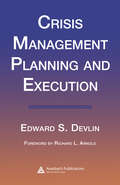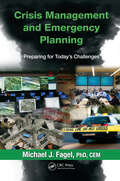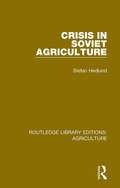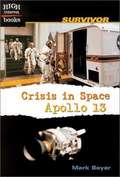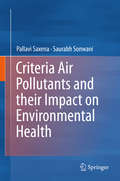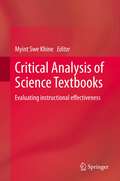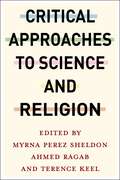- Table View
- List View
Crisis Averted: The Hidden Science of Fighting Outbreaks
by Caitlin Rivers PhD&“Readers should come away from Crisis Averted with a better comprehension of what public health does and why it is such a crucial endeavor.&” —The Washington Post"A master class in how we can pinpoint and prevent health crises before they spiral out of control."—Scott Gottlieb, MD, author of Uncontrolled SpreadA fascinating window into the secret life of epidemiology, weaving together stories of triumph and tragedy, with a boots-on-the-ground perspective on how we can avert the next public health crisisThere are few visible markers of the accomplishments of public health. When epidemiologists do their jobs, nothing happens. An outbreak does not grow into an epidemic. A child does not go hungry. A would-be smoker never lights up. In this fascinating window into the secret life of public health, Caitlin Rivers weaves together stories of triumph and tragedy to show that by making sure things don't happen, she and legions of scientists, practitioners, and policymakers change the course of history.We have many of the tools and experiences needed to prevent the next crisis, but as past experiences teach us, the unexpected is always around the corner. We cannot afford complacency, as countless challenges remain, including constantly emerging pathogens, the rapid growth of biotechnology, and the inconsistent cycles of funding for public health programs. Progress can be slow, but the unsung heroes in epidemiology remain focused on their missions. Crisis Averted tells their stories—from the eradication of smallpox in the twentieth century to a battle against mosquito-borne diseases in the Florida Keys to the international safeguards implemented against extraterrestrial germs. By taking a candid look at how we solve problems in public health, Caitlin Rivers illuminates the role of epidemiology in all our lives and lays out the case for what can be accomplished given sufficient vision, leadership, and resources. Crisis Averted is an inspiring and galvanizing call for us to work together towards a healthier, more resilient future.
Crisis Gardening: A Global Perspective (Advances in Agroecology)
by Monika EgererGardening during times of crisis can have significant benefits to individuals and populations interms of health, well-being, social and economic outcomes. So-called ‘crisis gardening’ can even belinked to transformative change in food systems through socio-ecological aspects of agroecology.In this book, crisis gardening is explored to better define, describe and provide recommendationsabout this activity globally. Diverse perspectives are offered from scholars around the world, providingan overview of gardening during crises with ties to agroecology. Such a perspective is criticalas we grapple with food system crises, pandemics, climate change, biodiversity loss, mental healthissues and political conflict globally.• The first section defines and explains crisis gardening in relation to agroecology, transformative change in food systems and public health.• The second section describes case studies from around the world of crisis gardening from various social-ecological perspectives.• The third section provides policy and practice recommendations and how to scale up the lessons from crisis gardening to transform food systems, public health systems, and policy and landscape planning processes.Bringing together leaders and experts (academics, policy makers and practitioners) from around theworld, the book provides case studies of crisis gardening and develops recommendations to harnessthe lessons from this practice.
Crisis Management Planning and Execution
by Edward S. DevlinCrisis management planning refers to the methodology used by executives to respond to and manage a crisis and is an integral part of a business resumption plan. Crisis Management Planning and Execution explores in detail the concepts of crisis management planning, which involves a number of crises other than physical disaster.Defining th
Crisis Management and Emergency Planning: Preparing for Today's Challenges
by Michael J. FagelEmergency managers and officials have seen a tremendous increase in the planning responsibilities placed on their shoulders over the last decade. Crisis Management and Emergency Planning: Preparing for Today's Challenges supplies time-tested insights to help communities and organizations become better prepared to cope with natural and manmade disas
Crisis Management of Chronic Pollution: Contaminated Soil and Human Health (Urbanization, Industrialization, and the Environment #1)
by Magalie Lesueur Jannoyer Philippe Cattan Thierry Woignier Florence ClostreCrisis Management of Chronic Pollution: Contaminated Soil and Human Health deals with a long term pollution problem, generated by the former use of organochlorine pesticides. Through a case study of the chlordecone pollution in the French West Indies, the authors illustrate a global and systemic mobilization of research institutions and public services. This "management model", together with its major results, the approach and lessons to be learned, could be useful to other situations. This book gathers all the works that have been carried out over the last ten years or more and links them to decision makers’ actions and stakeholders’ expectations. This reference fills a gap in the literature on chronic pollution.
Crisis Stability and Long-Range Strike: A Comparative Analysis of Fighters, Bombers, and Missiles
by Forrest E. MorganTo effectively manage an international crisis, the United States must balance its threats with restraint. It must posture forces in ways that deter aggression without implying that an attack is imminent, while limiting its own vulnerability to surprise attack. A RAND study sought to identify which long-range strike assetsâ#128;#148;strike fighters, bombers, ballistic missiles, cruise missilesâ#128;#148;offer capabilities most conducive to stabilizing such crises.
Crisis in Soviet Agriculture (Routledge Library Editions: Agriculture #8)
by Stefan HedlundThis book, first published in 1984, analyses the institutions and decision-making processes that determined agricultural production in the Soviet Union. It addresses the crisis in Soviet agriculture of the early 1980s, examining the problems of low productivity, adverse natural conditions and an underdeveloped infrastructure. The book’s analysis of the ‘crisis’ focuses on the growing gap between demand and supply of agricultural produce, and the pressures on the government to alleviate the food shortages.
Crisis in Space: Apollo 13
by Mark BeyerThe book recounts the events related to the ill-fated Apollo 13 mission and how the crew and mission control handled the inflight crisis.
Crisis in the Red Zone: The Story of the Deadliest Ebola Outbreak in History, and of the Outbreaks to Come
by Richard PrestonThe 2013–2014 Ebola epidemic was the deadliest ever—but the outbreaks continue. Now comes a gripping account of the doctors and scientists fighting to protect us, an urgent wake-up call about the future of emerging viruses—from the #1 bestselling author of The Hot Zone, now a National Geographic original miniseries. <P><P> This time, Ebola started with a two-year-old child who likely had contact with a wild creature and whose entire family quickly fell ill and died. The ensuing global drama activated health professionals in North America, Europe, and Africa in a desperate race against time to contain the viral wildfire. <P><P>By the end—as the virus mutated into its deadliest form, and spread farther and faster than ever before—30,000 people would be infected, and the dead would be spread across eight countries on three continents. In this taut and suspenseful medical drama, Richard Preston deeply chronicles the outbreak, in which we saw for the first time the specter of Ebola jumping continents, crossing the Atlantic, and infecting people in America. <P><P> Rich in characters and conflict—physical, emotional, and ethical—Crisis in the Red Zone is an immersion in one of the great public health calamities of our time. Preston writes of doctors and nurses in the field putting their own lives on the line, of government bureaucrats and NGO administrators moving, often fitfully, to try to contain the outbreak, and of pharmaceutical companies racing to develop drugs to combat the virus. He also explores the charged ethical dilemma over who should and did receive the rare doses of an experimental treatment when they became available at the peak of the disaster. <P><P> Crisis in the Red Zone makes clear that the outbreak of 2013–2014 is a harbinger of further, more severe outbreaks, and of emerging viruses heretofore unimagined—in any country, on any continent. In our ever more interconnected world, with roads and towns cut deep into the jungles of equatorial Africa, viruses both familiar and undiscovered are being unleashed into more densely populated areas than ever before. <P><P>The more we discover about the virosphere, the more we realize its deadly potential. Crisis in the Red Zone is an exquisitely timely book, a stark warning of viral outbreaks to come. <P><P><b> A New York Times Bestseller</b>
Crisis of the Wasteful Nation
by Ian TyrrellLong before people were "going green" and toting reusable bags, the Progressive generation of the early 1900s was calling for the conservation of resources, sustainable foresting practices, and restrictions on hunting. Industrial commodities such as wood, water, soil, coal, and oil, as well as improvements in human health and the protection of "nature" in an aesthetic sense, were collectively seen for the first time as central to the country's economic well-being, moral integrity, and international power. One of the key drivers in the rise of the conservation movement was Theodore Roosevelt, who, even as he slaughtered animals as a hunter, fought to protect the country's natural resources. In Crisis of the Wasteful Nation, Ian Tyrrell gives us a cohesive picture of Roosevelt's engagement with the natural world along with a compelling portrait of how Americans used, wasted, and worried about natural resources in a time of burgeoning empire. Countering traditional narratives that cast conservation as a purely domestic issue, Tyrrell shows that the movement had global significance, playing a key role in domestic security and in defining American interests around the world. Tyrrell goes beyond Roosevelt to encompass other conservation advocates and policy makers, particularly those engaged with shaping the nation's economic and social policies--policies built on an understanding of the importance of crucial natural resources. Crisis of the Wasteful Nation is a sweeping transnational work that blends environmental, economic, and imperial history into a cohesive tale of America's fraught relationships with raw materials, other countries, and the animal kingdom.
Crisis on the Coast and Hinterland: Assessing India’s East Coast with Geomorphological, Environmental and Remote Sensing and GIS Approaches
by Ashis Kumar Paul Anurupa PaulThis contributed volume assesses the state and future of India’s East Coast through a wide variety of chapters grouped by methodology and approach. Part I: Assessment through Geomorphological Approaches describes geomorphological diversities of the eastern shorelines of India, Coastal Modelling System- SMC and morphodynamics of Odisha coast, Paleo shorelines and beach ridge chenier formations of Subarnarekha delta, seasonal sediment budget of Chandrabhaga beachdune system, Beach stage and dune stage modelling Mandarmoni coast, drainage characters of South Andaman Islands, coastal foredune morphology and sediment of Odisha and West Bengal, Geo-archaeological pieces of evidence of ancient coastal environment, coastal sediment characters, beach ridge formation in the chenier coast, and geomorphological changes of ancient ports and harbours in the shoreline of West Bengal. Part II: Assessment through Environmental Approaches addresses various environmental assessment techniques of mangrove sensitivity to the sea level rise process in the Sundarban, land degradation of the hinterland drainage basins, the riparian environment of the coastal drainage basins, agricultural adaptability in response to climate variability in the coastal areas of West Bengal, forest degradations of the lateritic upland tracts, coastal tourism potentialities in Odisha and West Bengal, Climate variabilities and agricultural modifications in the hinterland areas of West Bengal districts, the tidal flat environment of Sagar Island, landforms and Geomorphosites for the promotion of Geotourism in South Andaman Perils of Premature Reclamation of Sundarban, marine litter in the coastal regions of West Bengal and Odisha on flora, fauna and humans, Ground water contamination due to saline water encroachment in coastal Andhra Pradesh and Spatio-temporal changes in the Hugli estuarine environment and coastal hazards and flood risk of southwestern Sundarban. Part III: Assessment through Remote Sensing & GIS Approaches uses the aforementioned techniques in service of exploration of monitoring health of Mangrove forest, Geomorphological analysis of the coral fringed coasts of Andaman, hydrological and morphological variations of Ichhamati Tidal estuary, multivariate analysis of coastal vulnerabilities, geography of tourism resources in Andaman group of islands, tourism climate index with application geospatial techniques, diversity of landscape ecology in the coastal blocks of Purba Medinipur, overwash vulnerability in Odisha coast, livelihood security index of the coastal communities, managing coastal squeeze response and wetland loss in the estuarine coastal tract of West Bengal, environmental effects of historical land reclamation process in the Sundarban, and emerging environmental problems of coastal urbanization in Digha, Kanthi, and Haldia.
Crispr: Methods and Protocols (Methods in Molecular Biology #1311)
by Magnus Lundgren Emmanuelle Charpentier Peter C. FineranThis volume presents a list of cutting-edge protocols for the study of CRISPR-Cas defense systems and their applications at the genomic, genetic, biochemical and structural levels. CRISPR: Methods and Protocols guides readers through techniques that have been developed specifically for the analysis of CRISPR-Cas and techniques adapted from standard protocols of DNA, RNA and protein biology. Written in the highly successful Methods in Molecular Biology series format, chapters include introductions to their respective topics, lists of the necessary materials and reagents, step-by-step, readily reproducible laboratory protocols, and tips on troubleshooting and avoiding known pitfalls. Authoritative and cutting-edge, CRISPR: Methods and Protocols provides a broad list of tools and techniques to study the interdisciplinary aspects of the prokaryotic CRISPR-Cas defense systems.
Criteria Air Pollutants and their Impact on Environmental Health
by Pallavi Saxena Saurabh SonwaniAir pollution is a global hazard. Majority of the world’s population is affected by air pollution. Contamination of air is no more an only an atmospheric problem but now has become a health concern too. Under the Clean Air Act of 1971, a set of air pollutants are designated as criteria pollutants. These are suspected to be strongly harming the public health and the environment as compared to other primary and secondary pollutants. Globally, this category of air pollutants has been given less attention, only few studies have been reported in this area. This book begins with a short background on criteria air pollutants and their sources, sinks and chemistry. The chapters explore the detailed nature of primary pollutants criteria pollutants such as nitrogen dioxide, sulphur dioxide, carbon monoxide, particulate matter and lead. Their reaction mechanisms, climate change potency, environmental health effects on plants and human life are discussed. The book also covers secondary pollutants such as ozone. The book discusses ozone chemistry and its environmental health effects. This book act as a valuable tool for students in Environmental Science, Biological Science and Agriculture, as well as environmental consultants and professionals involved in air quality research and the application of air quality guidelines and advice.
Critical Analysis of Science Textbooks: Evaluating instructional effectiveness
by Myint Swe KhineThe critical analysis of science textbooks is vital in improving teaching and learning at all levels in the subject, and this volume sets out a range of academic perspectives on how that analysis should be done. Each chapter focuses on an aspect of science textbook appraisal, with coverage of everything from theoretical and philosophical underpinnings, methodological issues, and conceptual frameworks for critical analysis, to practical techniques for evaluation. Contributions from many of the most distinguished scholars in the field give this collection its sure-footed contemporary relevance, reflecting the international standards of UNESCO as well as leading research organizations such as the American Association for the Advancement of Science (whose Project 2061 is an influential waypoint in developing protocols for textbook analysis). Thus the book shows how to gauge aspects of textbooks such as their treatment of controversial issues, graphical depictions, scientific historiography, vocabulary usage, accuracy, and readability. The content also covers broader social themes such as the portrayal of women and minorities. "Despite newer, more active pedagogies, textbooks continue to have a strong presence in classrooms and to embody students' socio-historical inheritance in science. Despite their ubiquitous presence, they have received relatively little on-going empirical study. It is imperative that we understand how textbooks influence science learning. This book presents a welcome and much needed analysis." Tina A. Grotzer Harvard University, Cambridge, Massachusetts, USA The present book provides a much needed survey of the current state of research into science textbooks, and offers a wide range of perspectives to inform the 'science' of writing better science textbooks. Keith S Taber University of Cambridge, Cambridge, United Kingdom
Critical Approaches to Science and Religion
by Sheldon, Myrna Perez; Ragab, Ahmed; Keel, TerenceCritical Approaches to Science and Religion offers a new direction for scholarship on science and religion that examines social, political, and ecological concerns long part of the field but never properly centered. The works that make up this volume are not preoccupied with traditional philosophical or theological issues. Instead, the book draws on three vital schools of thought: critical race theory, feminist and queer theory, and postcolonial theory. Featuring a diverse array of contributors, it develops critical perspectives by examining how histories of empire, slavery, colonialism, and patriarchy have shaped the many relationships between science and religion in the modern era. In so doing, this book lays the groundwork for scholars interested in speaking directly to matters such as climate change, structural racism, immigration, health care, reproductive justice, and sexual identity.
Critical Aspects of EPA's IRIS Assessment of Inorganic Arsenic
by Committee on Inorganic ArsenicThe US Environmental Protection Agency (EPA) Integrated Risk Information System (IRIS) program develops toxicologic assessments of environmental contaminants. IRIS assessments provide hazard identification and dose-response assessment information. The information is then used in conjunction with exposure information to characterize risks to public health and may be used in risk-based decisionmaking, in regulatory actions, and for other risk-management purposes. Since the middle 1990s, EPA has been in the process of updating the IRIS assessment of inorganic arsenic. In response to a congressional mandate for an independent review of the IRIS assessment of inorganic arsenic, EPA requested that the National Research Council convene a committee to conduct a two-phase study. "Critical Aspects of EPA's IRIS Assessment of Inorganic Arsenic" is the report of the first phase of that study. This report evaluates critical scientific issues in assessing cancer and noncancer effects of oral exposure to inorganic arsenic and offers recommendations on how the issues could be addressed in EPA's IRIS assessment.
Critical Campus Sustainabilities: Bridging Social Justice and the Environment in Higher Education (Sustainable Development Goals Series)
by Flora Lu Emily MuraiIn response to student demands reflecting the urgency of societal and ecological problems, universities are making a burgeoning effort to infuse environmental sustainability efforts with social justice. In this edited volume, we extend calls for higher education leaders to revamp programming, pedagogy, and research that problematically reproduce dominant techno-scientific and managerial conceptualizations of sustainability. Students, staff and community partners, especially those from historically underrepresented and marginalized groups, are at the forefront of calls for critical sustainabilities programming, education and collaborations. Their work centers themes of power relations, (in)equity, accessibility, and social (in)justice to study the interrelationships between humans, non-humans, and the environment. Their voices, perspectives and lived experiences are provocations for institutions to think and act more expansively. This book amplifies some of these voices and bottom up efforts toward a more critical approach to sustainability on campus. We ground our recommendations on findings from campus-wide surveys that were taken by over 8,000 undergraduates in 2016, 2019, and 2022. Furthermore, we share the design principles and lessons learned from several innovative, award-winning initiatives designed to foster critical sustainabilities at UC Santa Cruz.
Critical Care Management for Laboratory Mice and Rats (Laboratory Animal Pocket Reference)
by F. Claire HankensonFor critical care of laboratory rodents, there is a scarcity of sources for comprehensive, feasible, and response-oriented information on clinical interventions specific to spontaneous and induced models of disease. With the more complex cases that need critical care management, many treatment approaches to veterinary emergencies cannot be applied
Critical Dynamics
by Uwe C. TäuberIntroducing a unified framework for describing and understanding complex interacting systems common in physics, chemistry, biology, ecology, and the social sciences, this comprehensive overview of dynamic critical phenomena covers the description of systems at thermal equilibrium, quantum systems, and non-equilibrium systems. Powerful mathematical techniques for dealing with complex dynamic systems are carefully introduced, including field-theoretic tools and the perturbative dynamical renormalization group approach, rapidly building up a mathematical toolbox of relevant skills. Heuristic and qualitative arguments outlining the essential theory behind each type of system are introduced at the start of each chapter, alongside real-world numerical and experimental data, firmly linking new mathematical techniques to their practical applications. Each chapter is supported by carefully tailored problems for solution, and comprehensive suggestions for further reading, making this an excellent introduction to critical dynamics for graduate students and researchers across many disciplines within physical and life sciences.
Critical Ethology and Post-Anthropocentric Ethics: Beyond the Separation between Humanities and Life Sciences (Numanities - Arts and Humanities in Progress #16)
by Roberto Marchesini Marco CelentanoThe primary purpose of this book is to contribute to an overcoming of the traditional separation between humanties and life sciences which, according to the authors, is required today both by the developments of these disciplines and by the social problems they have to face. The volume discusses the theoretical, epistemological and ethical repercussions of the main acquisitions obtained in the last decades from the behavioral sciences. Both the authors are inspired by the concept of a “critical ethology”, oriented to archive the nature/culture and human/animal dichotomies. The book proposes a theoretical and methodological restructuring of the comparative study of the animal behavior, learning, and cultures, focused on the fact that thought, culture and language are not exclusively human prerogatives. The proposed analysis includes a critique of speciesism and determinism in the ethical field, and converge with the Numanities, to which the series is dedicated, on a key point: it is necessary to arrive at an education system able to offer scientific, social and ethical skills that are trasversal and transcendent to the traditional humanities/life sciences bipartition. Skills that are indispensable for facing the complex challenges of the contemporary society and promoting a critical reflection of humanity on itself.
Critical Factors Associated with Environmental, Social and Governance Management in Organizations (Accounting, Finance, Sustainability, Governance & Fraud: Theory and Application)
by Marcelo Jasmim Meiriño Osvaldo Luiz Gonçalves QuelhasThis book offers a comprehensive exploration of Environmental, Social, and Governance (ESG) principles, showing how they can be harnessed to enhance organizational sustainability. In an era where ESG is gaining increasing recognition for its transformative potential, this work delves into the practical aspects of leveraging ESG to improve governance, bolster corporate image, build credibility, and foster reputation. It also unveils the exciting realm of new business opportunities, particularly in the domains of social and environmental responsibility. What sets this book apart is its hands-on approach. Each chapter unfolds with compelling real-life case studies that draw readers into the dynamic world of ESG. As you progress through the pages, readers encounter thought-provoking questions and challenging case scenarios, inviting you to not just passively absorb information, but actively engage with the material. The readers are prompted to reflect on these cases, formulate questions, and even tackle proposed solutions, making readers’ learning experience highly interactive and deeply insightful. The main benefit readers will derive from this work is a panoramic understanding of ESG—from its theoretical underpinnings to its practical implementation. Beyond just providing knowledge, this book equips the reader with a toolkit of ESG management strategies that can be implemented in their own organizations.
Critical Forensic Studies (Global Issues in Crime and Justice)
by Rob White Roberta Julian Loene HowesThis book provides a comprehensive overview of the emerging interdisciplinary field of critical forensic studies. It reviews existing research and scholarship on forensic science from a critical social science perspective, while forging a blueprint for further work in this area. Forensic science has long captured the public imagination, as evidenced by the popularity of many novels, television programmes, and true-crime podcasts. At the same time, its role in the criminal justice system has been the subject of critique from scholars and practitioners in diverse fields. In response, the international forensic science community has become more involved in the scrutiny of its own knowledge and practices in relation to criminal justice objectives. Moving beyond a discussion of forensic science as a suite of specialised scientific disciplines that aim to provide evidence to the courts, Critical Forensic Studies offers critical insights relevant to a wide range of social actors in the criminal justice system. Core content includes: • the history and public understandings of forensic science• the professionalisation of forensic science• forensic science as a social process• crime scene examination and forensic intelligence• experts and evidence in court• technological advances and human rights• interdisciplinary knowledge, practice and research This book is essential reading for forensic and criminal justice practitioners and students across criminology, sociology, forensic science, law, and psychology.
Critical Heat Flux in Flow Boiling in Microchannels (SpringerBriefs in Applied Sciences and Technology)
by Sujoy Kumar Saha Gian Piero CelataThis Brief concerns the important problem of critical heat flux in flow boiling in microchannels. A companion edition in the SpringerBrief Subseries on Thermal Engineering and Applied Science to "Heat Transfer and Pressure Drop in Flow Boiling in Microchannels," by the same author team, this volume is idea for professionals, researchers, and graduate students concerned with electronic cooling.
Critical Incident Management
by Alan B. SterneckertMost businesses are aware of the danger posed by malicious network intruders and other internal and external security threats. Unfortunately, in many cases the actions they have taken to secure people, information and infrastructure from outside attacks are inefficient or incomplete. Responding to security threats and incidents requires a competent
Critical Incident Management: A Complete Response Guide, Second Edition
by Vincent Faggiano Thomas T. Gillespie John McNallTerrorism threats and increased school and workplace violence have always generated headlines, but in recent years, the response to these events has received heightened media scrutiny. Critical Incident Management: A Complete Resource Guide, Second Edition provides evidence-based, tested, and proven methodologies applicable to a host of scenarios t


